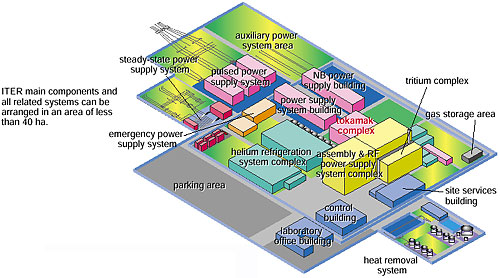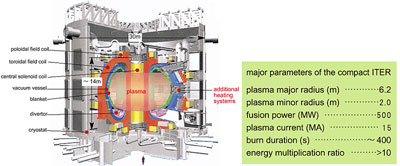 |
Fig. 3-23 Generic ITER Site View |
 This picture, (100KB) |
Fig. 3-24 ITER Tokamak Device |
| For developing the ultimate peaceful energy, an engineering design of ITER has been conducted within a world-wide joint framework. During the design activities, JAERI, as a core institute in Japan, has extensively promoted the ITER project. The ITER project is a very important step to demonstrate the scientific and technological feasibility of fusion power for peaceful purposes and is consistent with the Japanese fusion research program authorized by Atomic Energy Commission of Japan. Engineering design activities began in 1992 by international co-operation of the European Union, Japan, the Russian Federation and the United States of America. ITER would achieve its goal by demonstrating controlled ignition and extended burn of Deuterium-Tritium plasmas, with steady-state as an ultimate goal, by demonstrating technologies essential to a reactor in an integrated system, and by performing integrated testing of high-heat flux/nuclear components required to utilize fusion energy for practical purposes. In 1998, the ITER Parties, however, were unable to proceed to the construction of the foreseen device due to financial reasons, and decided to modify its technical goal, with no change of the programmatic objectives. Since 1998, we have intensively been conducting a compact ITER design on the basis of progressive physics and technology R&D results, and completed the engineering design as the ITER Final Design Report in 2001. There are no remaining issues for a construction decision and therefore, ITER is now ready for a decision on construction. |
| Reference Y. Shimomura, The New ITER, Purazuma, Kaku Yugo Gakkai-Shi, 76(9), 949 (2000). |
| Select a topic in left column |  |
| Persistent Quest - Research Activities 2001 Copyright(c) Japan Atomic Energy Research Institute |